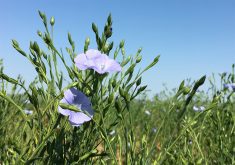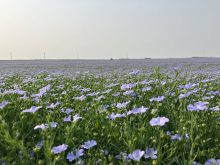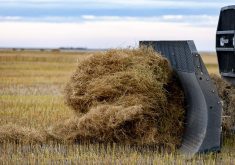Research has found that the crop responds well to nitrogen applications, but not so much to phosphorus
Flax is often thought of as a low input crop that doesn’t respond well to fertilizer applications.
However, the crop’s nutrient requirements are right up there with canola when compared on a per bushel basis.
“If you want to get into that high 30 bu. per acre plus, we certainly do need to add some nutrients, including phosphorus and sulfur,” said Chris Holzapfel of the Indian Head Agricultural Research Foundation.
“When it comes to sulfur, the per bushel requirements of flax are actually a little bit higher than with canola.”
Read Also

Growing garlic by the thousands in Manitoba
Grower holds a planting party day every fall as a crowd gathers to help put 28,000 plants, and sometimes more, into theground
Holzapfel told a recent flax agronomy presentation at a farm meeting in Saskatoon that the crop can respond to nutrient applications.
“If we want to achieve consistently high yields and more importantly reduce the variability of yields we get from year to year, then it’s important to maybe change the way we think about it and at least be prepared to give it what it needs,” he said.
A 24 bu. per acre flax crop requires 70 pounds of nitrogen per acre, either from the soil or as applied fertilizer, 20 lb. of phosphorus, 44 lb. of potassium and 14 lb. of sulfur.
Holzapfel said a 40 bu. flax crop will need considerably more nutrients, including 120 lb. per acre of actual nitrogen, which goes to show how responsive the crop is to fertilizer,
However, flax does not respond quickly to phosphorus applications, especially compared to canola, which can be adjusted for a phosphorus deficiency by adding more of the nutrient during seeding.
Instead, it’s best to grow flax on fields where high levels of residual phosphorus already exist.
“With soybeans or flax, a great place to put them on is if you have fields where you want to mop up some of those nutrients,” Holzapfel said.
Getting flax established and off to a healthy start is one of the more difficult aspects of growing the crop.
Holzapfel said his first choice would be to plant flax in cereal stubble, but the crop can also do well when planted after a pulse crop.
“One thing to avoid would be canola or mustard stubble. We tend to see a bit of a yield drag there.”
As well, any crop commonly grown in Western Canada can be successfully planted into flax stubble, including canola.
“Something that we hear occasionally is that flax is hard on the soil. I would challenge that,” Holzapfel said.
Emergence and establishment can be variable, but higher plant populations can promote more uniform maturity across the field, especially in a varying landscape.
A minimum of 300 plants per sq. metre is recommended, but higher densities can hasten maturity.
Holzapfel said he favours seeding rates of 40 to 50 lb. per acre.
“Bumping up those seeding rates might be a cost effective way to reduce maturity and make your field more uniform,” he said.
“With that in mind, we will often go up to 50 lb. per acre with our rates. It gives us a little more of a buffer for harsher environmental conditions and also ensures a nice uniform field.”
Flax is sensitive to seed-placed fertilizer, and it is not recommended to apply more than 15 to 20 lb. per acre of actual phosphorus in the seed row. However, that is often not enough to meet the crop’s total nutrient requirements or replace the nutrients that it removes.
Many producers often seed flax last because it can catch up quickly and the yield increases obtained from planting it early are less than the yield increases from planting crops such as canola early.
However, Holzapfel said producers shouldn’t be afraid to plant flax early because the crop can survive an early frost better than canola and is less vulnerable to early season pests than other crops.
Flax is sensitive to row spacing because its canopy is not aggressive and weeds can quickly overtake the short crop.
Holzapfel said a study found no yield differences when flax was grown in row spacings ranging from four to 12 inches, but a study he was involved in found that plant populations decreased and yields were reduced when row spacing increased past 10 to 12 inches.
“If you do have a drill that has 15 inch spacing, I certainly wouldn’t suggest that you can’t grow flax,” he said.
“The differences are subtle, but when we look at our crops, this is certainly one of the most sensitive crops to large row spacing.”
Seed treatments are not commonly used with flax in Western Canada, and Vitaflo has been the only product registered for the crop.
However, a new product from BASF, Insure Pulse, is registered for the crop.
Holzapfel conducted trials with Vitaflo last year and found that it helped emergence and provided a slight yield benefit.
He also said a robust weed management program is important when growing flax.
PAMI studies found that the best broadleaf control came from Authority and Buctril M (MCPA and bromoxynil), but Buctril M and Curtail M (MCPA and clopyralid) also did well on their own for most weed species.
“If you have issues with Group 2 resistance, particularly with kochia, Authority is an option for flax,” Holzapfel said.
“It looks after a select number of weeds, but they do seem to be weeds that are hard to kill with other chemicals. It provides all season long control and goes down with your burnoff.…”
“It might make sense to delay seeding a little bit so you can get a good burn off and take care of that first flush of wild oats. If you have Group 1 resistant wild oats, you need to plan ahead for it (by using soil applied chemistries), but I wouldn’t deter you from growing, even then.”
Pasmo is the major flax disease, and Headline had traditionally been the only registered product. However, Priaxor, which has a couple modes of action, was recently registered for the crop.
“When the disease is heavy, we can see up to 30 percent yield increase,” Holzapfel said while presenting his research on the effectiveness of Headline on flax yields.
“When (disease pressure is) low, there is often only a marginal response to it.”
Scouting for pasmo can be tricky, and producers must watch for spots forming on the lower leafs and stems in the period leading up to flowering.
“There are already some of the lower leaves being lost in some of those years.”
A flax crop that is about to come into flowering should be checked in the morning.
“When you see the first sign of flowering, give yourself seven to 10 days and go out there and apply your fungicide application, and you’re going to hit what I would consider mid-bloom,” he said.
Growers should check the most recent seed guide for variety recommendations.
Contact robin.booker@producer.com


















